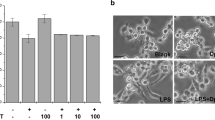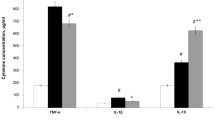Abstract
Previously, we reported that 3H-1,2-dithiole-3-thione (D3T), an Nrf2 activator, acted as a potential chemoprotectant against lipopolysaccharide (LPS)-induced mortality in mice. In view of the critical involvement of macrophages in the pathogenesis of LPS-induced endotoxemia, in the present study, we investigated the protective effects of D3T on LPS-induced proinflammatory responses in cultured murine RAW 264.7 macrophage cell line and primary peritoneal macrophages and the potential involvement of antioxidant induction, NF-κB, and Nrf2. We showed that treatment with D3T resulted in increased levels of a series of antioxidants in RAW 264.7 cells in a concentration-dependent manner. These included the reduced form of glutathione, glutathione peroxidase, glutathione reductase, glutathione S-transferase, and NADPH:quinone oxidoreductase 1. Catalase was also potently induced by D3T which, however, did not show a concentration dependency. Concurrent with the ability to induce the above cellular antioxidants, D3T pretreatment of RAW 264.7 cells also led to a concentration-dependent suppression of LPS-induced interleukin-1beta (IL-1β) production and nitric oxide release. LPS-stimulated tumor necrosis factor-alpha (TNF-α) production was also suppressed by D3T, but to a much lesser extent. Using NF-κB reporter gene-expressing RAW 264.7 cells, we further showed that D3T pretreatment also suppressed LPS-induced NF-κB activation. To investigate the potential involvement of Nrf2, a chief regulator of cellular antioxidant genes, we used peritoneal macrophages isolated from Nrf2+/+ and Nrf2−/− mice. Our results showed that D3T pretreatment suppressed LPS-induced proinflammatory responses in Nrf2+/+ macrophages, and this inhibitory effect of D3T was completely lost in Nrf2−/− macrophages. Collectively, the results of the present study demonstrated that D3T acted as a potent suppressor of LPS-induced proinflammatory responses in macrophages. Antioxidant induction, NF-κB suppression, and Nrf2 activation appeared to contribute to the anti-proinflammatory activity of D3T in macrophages.






Similar content being viewed by others
Data availability
The datasets generated during and/or analyzed during the current study are available from the corresponding author on reasonable request.
References
Rudd KE, Johnson SC, Agesa KM, Shackelford KA, Tsoi D, Kievlan DR, Colombara DV, Ikuta KS, Kissoon N, Finfer S, Fleischmann-Struzek C, Machado FR, Reinhart KK, Rowan K, Seymour CW, Watson RS, West TE, Marinho F, Hay SI, Lozano R, Lopez AD, Angus DC, Murray CJL, Naghavi M (2020) Global, regional, and national sepsis incidence and mortality, 1990–2017: analysis for the Global Burden of Disease Study. Lancet 395:200–211. https://doi.org/10.1016/S0140-6736(19)32989-7
Cohen J, Vincent JL, Adhikari NK, Machado FR, Angus DC, Calandra T, Jaton K, Giulieri S, Delaloye J, Opal S, Tracey K, van der Poll T, Pelfrene E (2015) Sepsis: a roadmap for future research. Lancet Infect Dis 15:581–614. https://doi.org/10.1016/S1473-3099(15)70112-X
Seymour CW, Rosengart MR (2015) Septic shock: advances in diagnosis and treatment. JAMA 314:708–717. https://doi.org/10.1001/jama.2015.7885
Cecconi M, Evans L, Levy M, Rhodes A (2018) Sepsis and septic shock. Lancet 392:75–87. https://doi.org/10.1016/S0140-6736(18)30696-2
Liu SF, Malik AB (2006) NF-kappa B activation as a pathological mechanism of septic shock and inflammation. Am J Physiol Lung Cell Mol Physiol 290:L622–L645. https://doi.org/10.1152/ajplung.00477.2005
Kong X, Thimmulappa R, Craciun F, Harvey C, Singh A, Kombairaju P, Reddy SP, Remick D, Biswal S (2011) Enhancing Nrf2 pathway by disruption of Keap1 in myeloid leukocytes protects against sepsis. Am J Respir Crit Care Med 184:928–938. https://doi.org/10.1164/rccm.201102-0271OC
Kwak MK, Egner PA, Dolan PM, Ramos-Gomez M, Groopman JD, Itoh K, Yamamoto M, Kensler TW (2001) Role of phase 2 enzyme induction in chemoprotection by dithiolethiones. Mutat Res 480–481:305–315. https://doi.org/10.1016/s0027-5107(01)00190-7
Kwak MK, Wakabayashi N, Itoh K, Motohashi H, Yamamoto M, Kensler TW (2003) Modulation of gene expression by cancer chemopreventive dithiolethiones through the Keap1-Nrf2 pathway. Identification of novel gene clusters for cell survival. J Biol Chem 278:8135–8145. https://doi.org/10.1074/jbc.M211898200
Cao Z, Li Y (2004) The chemical inducibility of mouse cardiac antioxidants and phase 2 enzymes in vivo. Biochem Biophys Res Commun 317:1080–1088. https://doi.org/10.1016/j.bbrc.2004.03.156
Zhu H, Zhang L, Itoh K, Yamamoto M, Ross D, Trush MA, Zweier JL, Li Y (2006) Nrf2 controls bone marrow stromal cell susceptibility to oxidative and electrophilic stress. Free Radic Biol Med 41:132–143. https://doi.org/10.1016/j.freeradbiomed.2006.03.020
Zhu H, Jia Z, Zhang L, Yamamoto M, Misra HP, Trush MA, Li Y (2008) Antioxidants and phase 2 enzymes in macrophages: regulation by Nrf2 signaling and protection against oxidative and electrophilic stress. Exp Biol Med (Maywood) 233:463–474. https://doi.org/10.3181/0711-RM-304
Otieno MA, Kensler TW, Guyton KZ (2000) Chemoprotective 3H–1,2-dithiole-3-thione induces antioxidant genes in vivo. Free Radic Biol Med 28:944–952. https://doi.org/10.1016/s0891-5849(00)00175-1
Burton NC, Kensler TW, Guilarte TR (2006) In vivo modulation of the Parkinsonian phenotype by Nrf2. Neurotoxicology 27:1094–1100. https://doi.org/10.1016/j.neuro.2006.07.019
Cao Z, Zhu H, Zhang L, Zhao X, Zweier JL, Li Y (2006) Antioxidants and phase 2 enzymes in cardiomyocytes: Chemical inducibility and chemoprotection against oxidant and simulated ischemia-reperfusion injury. Exp Biol Med (Maywood) 231:1353–1364. https://doi.org/10.1177/153537020623100809
Zhu H, Itoh K, Yamamoto M, Zweier JL, Li Y (2005) Role of Nrf2 signaling in regulation of antioxidants and phase 2 enzymes in cardiac fibroblasts: protection against reactive oxygen and nitrogen species-induced cell injury. FEBS Lett 579:3029–3036. https://doi.org/10.1016/j.febslet.2005.04.058
Zhu H, Jia Z, Misra BR, Zhang L, Cao Z, Yamamoto M, Trush MA, Misra HP, Li Y (2008) Nuclear factor E2-related factor 2-dependent myocardiac cytoprotection against oxidative and electrophilic stress. Cardiovasc Toxicol 8:71–85. https://doi.org/10.1007/s12012-008-9016-0
Li YR, Jia Z, Zhu H (2019) 3H–1,2-dithiole-3-thione as a potentially novel therapeutic compound for sepsis intervention. React Oxyg Species 8:202–212
Mills EL, Kelly B, Logan A, Costa ASH, Varma M, Bryant CE, Tourlomousis P, Dabritz JHM, Gottlieb E, Latorre I, Corr SC, McManus G, Ryan D, Jacobs HT, Szibor M, Xavier RJ, Braun T, Frezza C, Murphy MP, O’Neill LA (2016) Succinate dehydrogenase supports metabolic repurposing of mitochondria to drive inflammatory macrophages. Cell 167(457–470):e13. https://doi.org/10.1016/j.cell.2016.08.064
Zhu H, Cao Z, Zhang L, Trush MA, Li Y (2007) Glutathione and glutathione-linked enzymes in normal human aortic smooth muscle cells: chemical inducibility and protection against reactive oxygen and nitrogen species-induced injury. Mol Cell Biochem 301:47–59. https://doi.org/10.1007/s11010-006-9396-z
Hopkins RZLY (2020) Essentials of antioxidant biology and medicine. Cell Med Press, Raleigh, NC
Zhu H, Jia Z, Mahaney JE, Ross D, Misra HP, Trush MA, Li Y (2007) The highly expressed and inducible endogenous NAD(P)H:quinone oxidoreductase 1 in cardiovascular cells acts as a potential superoxide scavenger. Cardiovasc Toxicol 7:202–211. https://doi.org/10.1007/s12012-007-9001-z
Mittal M, Siddiqui MR, Tran K, Reddy SP, Malik AB (2014) Reactive oxygen species in inflammation and tissue injury. Antioxid Redox Signal 20:1126–1167. https://doi.org/10.1089/ars.2012.5149
Johnson DW, Kalil AC (2016) Is interleukin-1 receptor blockade ready for prime time in patients with severe sepsis and macrophage activation syndrome? Crit Care Med 44:443–444. https://doi.org/10.1097/CCM.0000000000001460
Xie QW, Whisnant R, Nathan C (1993) Promoter of the mouse gene encoding calcium-independent nitric oxide synthase confers inducibility by interferon gamma and bacterial lipopolysaccharide. J Exp Med 177:1779–1784. https://doi.org/10.1084/jem.177.6.1779
Weinberg JB, Misukonis MA, Shami PJ, Mason SN, Sauls DL, Dittman WA, Wood ER, Smith GK, McDonald B, Bachus KE et al (1995) Human mononuclear phagocyte inducible nitric oxide synthase (iNOS): analysis of iNOS mRNA, iNOS protein, biopterin, and nitric oxide production by blood monocytes and peritoneal macrophages. Blood 86:1184–1195
Liu Y, Fang S, Li X, Feng J, Du J, Guo L, Su Y, Zhou J, Ding G, Bai Y, Wang S, Wang H, Liu Y (2017) Aspirin inhibits LPS-induced macrophage activation via the NF-kappaB pathway. Sci Rep 7:11549. https://doi.org/10.1038/s41598-017-10720-4
Zhang Q, Lenardo MJ, Baltimore D (2017) 30 Years of NF-kappaB: a blossoming of relevance to human pathobiology. Cell 168:37–57. https://doi.org/10.1016/j.cell.2016.12.012
Thimmulappa RK, Lee H, Rangasamy T, Reddy SP, Yamamoto M, Kensler TW, Biswal S (2006) Nrf2 is a critical regulator of the innate immune response and survival during experimental sepsis. J Clin Invest 116:984–995. https://doi.org/10.1172/JCI25790
Yao X, Carlson D, Sun Y, Ma L, Wolf SE, Minei JP, Zang QS (2015) Mitochondrial ROS induces cardiac inflammation via a pathway through mtDNA damage in a pneumonia-related sepsis model. PLoS ONE 10:e0139416. https://doi.org/10.1371/journal.pone.0139416
Zhu H, Jia Z, Zhou K, Misra HP, Santo A, Gabrielson KL, Li Y (2009) Cruciferous dithiolethione-mediated coordinated induction of total cellular and mitochondrial antioxidants and phase 2 enzymes in human primary cardiomyocytes: cytoprotection against oxidative/electrophilic stress and doxorubicin toxicity. Exp Biol Med 234:418–429. https://doi.org/10.3181/0811-RM-340
Jia Z, Zhu H, Trush MA, Misra HP, Li Y (2008) Generation of superoxide from reaction of 3H–1,2-dithiole-3-thione with thiols: implications for dithiolethione chemoprotection. Mol Cell Biochem 307:185–191. https://doi.org/10.1007/s11010-007-9598-z
Rushworth SA, MacEwan DJ, O’Connell MA (2008) Lipopolysaccharide-induced expression of NAD(P)H:quinone oxidoreductase 1 and heme oxygenase-1 protects against excessive inflammatory responses in human monocytes. J Immunol 181:6730–6737. https://doi.org/10.4049/jimmunol.181.10.6730
Acknowledgements
This study was supported in part by a grant from the National Institutes of Health (GM124652). The Berthold LB9505 luminometer was provided by Dr. Michael A. Trush from The Johns Hopkins University (Baltimore, MD).
Funding
This study was supported in part by a Grant (GM124652) from the National Institutes of Health, Bethesda, MD.
Author information
Authors and Affiliations
Contributions
All authors contributed to the study conception, design, performance, data analysis, and writing. All authors read and approved the final manuscript.
Corresponding author
Ethics declarations
Conflict of interest
The authors have no relevant financial or non-financial interest to disclose.
Ethical approval
This work does not directly involve intact animals or human subjects. The experimental protocol for the isolation of the primary peritoneal macrophages from Nrf2+/+ and Nrf2−/− mice (on C57BL/6 background) was approved by the Institutional Animal Care and Use Committee as described in Ref [9], and the cells has been kept in liquid nitrogen ever since and were used in the present study for generating the data presented in Fig. 5.
Additional information
Publisher's Note
Springer Nature remains neutral with regard to jurisdictional claims in published maps and institutional affiliations.
Rights and permissions
About this article
Cite this article
Zhu, H., Bui, A., Santo, A. et al. 3H-1,2-dithiole-3-thione suppresses LPS-induced proinflammatory responses in macrophages: potential involvement of antioxidant induction, NF-κB, and Nrf2. Mol Cell Biochem 477, 1499–1506 (2022). https://doi.org/10.1007/s11010-021-04331-x
Received:
Accepted:
Published:
Issue Date:
DOI: https://doi.org/10.1007/s11010-021-04331-x




